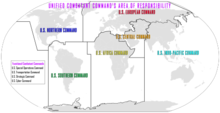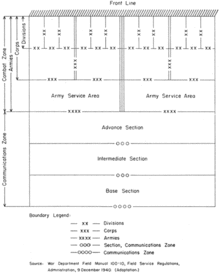| Part of a series on |
| War (outline) |
|---|
 |
In warfare, a theater or theatre is an area in which important military events occur or are in progress.[1][2] A theater can include the entirety of the airspace, land, and sea area that is—or that may potentially become—involved in war operations.[3]
Theater of war
[edit]In his book On War, Carl von Clausewitz defines the term Kriegstheater (translating the older, 17th-century Latin term theatrum belli) as one that:
Denotes properly such a portion of the space over which war prevails as has its boundaries protected, and thus possesses a kind of independence. This protection may consist of fortresses, or important natural obstacles presented by the country, or even in its being separated by a considerable distance from the rest of the space embraced in the war. Such a portion is not a mere piece of the whole, but a small whole complete in itself; and consequently it is more or less in such a condition that changes which take place at other points in the seat of war have only an indirect and no direct influence upon it. To give an adequate idea of this, we may suppose that on this portion an advance is made, whilst in another quarter a retreat is taking place, or that upon the one an army is acting defensively, whilst an offensive is being carried on upon the other. Such a clearly defined idea as this is not capable of universal application; it is here used merely to indicate the line of distinction.[4]
Theater of operations
[edit]Theater of operations (TO) is a sub-area within a theater of war. The boundary of a TO is defined by the commander who is orchestrating or providing support for specific combat operations within the TO.
Theater of operations is divided into strategic directions or military regions depending on whether it is a war or peacetime. Unified combatant commands of the Department of Defense (United States) have responsibility for military activities (combat and non-combat) within their area of responsibility.
Soviet and Russian Armed Forces
[edit]The Soviet and Russian Armed Forces classify a large geographic subdivision—such as continental geographic territories with their bordering maritime areas, islands, adjacent coasts[5] and airspace—as a theater. The Russian-language term for a military "theater" is театр военных действий, teatr voennykh deistvii (literally: "theater of military operations"), abbreviated ТВД, TVD.
This geographical division aids strategic and operational planning, allowing military operations of fronts. Fronts were originally named in accordance with their theater of operations; for example the Southwestern Front (Russian Empire) (1914–1918), the 1st Ukrainian Front (1943–1945, which fought in Ukraine, Poland, Germany, and Czechoslovakia), and the Northern Front (Soviet Union) (June to August 1941). In peacetime, lacking the urgencies of a strategic direction, fronts were transformed into military regions (districts) responsible for an assigned section of operations.
In 1986 the U.S. Department of Defense's Soviet Military Power identified ten continental and four oceanic TVDs, however, most being merely geographical areas without forces or headquarters: North American, South American, African, Australian, Antarctic, Arctic Ocean, Atlantic, Indian Ocean, and Pacific.[6] Four others - the Far Eastern, Western, South-Western, and Southern, had identified headquarters established in 1979 and 1984. Plans appear to have existed to form a Northwestern TVD headquarters on the basis of the Staff of the Leningrad Military District.[7]
In their most modern form, High Commands for the TVDs were first reestablished in February 1979 for the Far East.[8] Harrison wrote in the 2020s that the new command encompassed the Far East Military District and the Transbaikal Military District.[9] An official military encyclopedia published after the Fall of the Soviet Union stated, said Harrison, that the Soviet Pacific Fleet, an air army, and an air defence corps were also operationally subordinated to the new formation; and that the high command "coordinated" with the armies of Vietnam, Laos, Cambodia, and Mongolia.[10] The headquarters was set up at Ulan-Ude, near Lake Baikal. The RAND Corporation said in 1984 that the Soviet air and ground forces in Mongolia [subordinate to the Transbaikal Military District] and elements of the Mongolian Ground Forces and Mongolian Air Force were also at its disposal.[11] In September 1984 three more High Commands were established: the Western (HQ Legnica), South-Western (HQ Kishinev), and Southern (HQ Baku)[8][12]
United States
[edit]

The term theater of operations was defined in the American field manuals as the land and sea areas to be invaded or defended, including areas necessary for administrative activities incident to the military operations (chart 12). In accordance with the experience of World War I, it was usually conceived of as a large land mass over which continuous operations would take place and was divided into two chief areas—the combat zone, or the area of active fighting, and the communications zone, or area required for administration of the theater. As the armies advanced, both these zones and the areas into which they were divided would shift forward to new geographic areas of control.[13]
See also
[edit]- Battlespace
- China Burma India Theater
- European Theater of Operations
- European theatre of World War II
- AfPak
- Locus of control
- Unified Combatant Command
- Western Theater of the American Civil War
- Formations of the Soviet Army
- Theater commands of the People's Liberation Army
References
[edit]- ^ "Definition of theatre noun (MILITARY) from Cambridge Dictionary Online: Free English Dictionary and Thesaurus". Dictionary.cambridge.org. Retrieved 2011-08-31.
- ^ "Theater (warfare) – definition of Theater (warfare) by the Free Online Dictionary, Thesaurus and Encyclopedia". Thefreedictionary.com. Retrieved 2011-08-31.
- ^ "theatre of war, theatres of war- WordWeb dictionary definition". www.wordwebonline.com.
- ^ Carl von Clausewitz (1956). On War. Jazzybee Verlag. p. 162. ISBN 9783849676056. Retrieved 2020-05-16.
- ^ See: Voennyj entsiklopedicheskij slovarj (BES) Военный энциклопедический словарь (ВЭС) [Military encyclopedic dictionary] (in Russian). Moscow: Военное издательство (ВИ). 1984. p. 732.
- ^ Department of Defense (United States) (March 1986). Soviet Military Power (PDF). pp. 12–14.
- ^ Warner, Bonan & Packman 1984, p. 15.
- ^ a b Holm 2015.
- ^ Harrison 2022, p. 374.
- ^ Harrison's source note is VE, 2: 418, which is probably Военная энциклопедия в 8 томах. Т. 2: Вавилония — Гюйс / Гл. ред. комиссии П. С. Грачёв. — М.: Воениздат, 1994. — 544 с. — ISBN 5-203-00299-1.
- ^ Warner, Bonan & Packman 1984, p. 17.
- ^ Odom 1998.
- ^ "Chapter VII: Prewar Army Doctrine for Theater". History.amedd.army.mil. Archived from the original on 2020-02-03. Retrieved 2011-08-31.
Sources
[edit]- Harrison, Richard W. (July 2022). The Soviet Army's High Commands in War and Peace, 1941–1992. Casemate Academic. ISBN 9781952715112.
- Holm, Michael (2015). "High Commands (Theatre Commands)".
- Odom, William E. (1998). The Collapse of the Soviet Military. New Haven and London: Yale University Press.
- Warner, Edward; Bonan; Packman (April 1984). Key Personnel and Organisations of the Soviet Military High Command (PDF). RAND Notes. RAND Corporation. Archived (PDF) from the original on 2014-05-31. Retrieved 8 October 2022.
| Military organization | ||||||||||||||||||||||||||||||||||||
|---|---|---|---|---|---|---|---|---|---|---|---|---|---|---|---|---|---|---|---|---|---|---|---|---|---|---|---|---|---|---|---|---|---|---|---|---|
 | ||||||||||||||||||||||||||||||||||||
|
||||||||||||||||||||||||||||||||||||